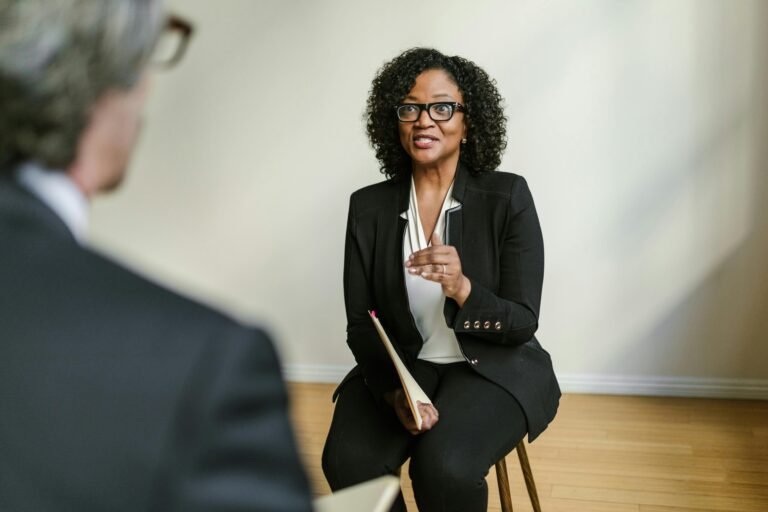When you walk into an interview for a school job (whether you’re applying to be a teacher, school counselor, principal, or custodian) your body language introduces you before you even speak.
School leaders aren’t just looking for skills on your resume; they’re observing how you carry yourself, how well you engage with others, and whether you seem like someone who fits their school culture.
From how you greet the front office staff to the way you sit across from the hiring panel, nonverbal communication is always in play. The good news is that with a little awareness and preparation, you can make your body language work with you, and not against you.
In this article, we’ll break down 10 in-person interview body language tips, offering real-world examples and concrete advice to help you project confidence, warmth, and readiness; naturally and authentically.
10 Body Language Tips to Make a Great In-Person Impression From Your First Handshake to Your Final Goodbye
1. Start Strong Before You Even Sit Down
What it looks like: You walk in with good posture, offer a firm handshake, make eye contact, and smile warmly.
Why it matters: First impressions happen fast. Your body language in those first few seconds can set the tone for the entire interview. You want to come across as confident, respectful, and genuinely interested.
Quick reminder: Greet everyone you meet, front office staff, other candidates, custodians, as if they’re part of the hiring team. Not only because everyone you meet should be treated with respect, but also because they just might be asked for their impression of you.
2. Sit with Purpose and Confidence
What it looks like: You sit upright, back straight, shoulders relaxed. Your feet are flat on the floor or crossed at the ankles—not bouncing or shifting constantly.
Why it matters: Your posture communicates your level of confidence and engagement. Slouching can signal disinterest or anxiety, while sitting stiffly may come off as guarded.
Try this: Take a calming breath as you sit, plant your feet, and relax your hands in your lap or on the armrest.
3. Make Natural Eye Contact
What it looks like: You make eye contact with the person speaking, and when you respond, you shift your gaze between members of the interview panel—not staring, not avoiding.
Why it matters: Eye contact builds connection and trust. It shows that you’re engaged and respectful of your audience.
Tip: If eye contact makes you nervous, look at the person’s eyebrows or bridge of the nose—it feels natural to them and takes the pressure off.
4. Smile Genuinely and Consistently
What it looks like: You smile warmly when greeting people, while listening, and when discussing moments you’re proud of or passionate about.
Why it matters: A real smile makes you more approachable and helps interviewers feel at ease with you. It also shows you’re excited about the opportunity.
Caution: Avoid forcing a constant smile—it can look nervous or inauthentic. Let your expressions reflect the tone of the moment.
5. Use Open, Relaxed Hand Gestures
What it looks like: Your hands support your communication with natural gestures. You don’t hide them under the table, fidget excessively, or cross your arms.
Why it matters: Open gestures help people understand and connect with what you’re saying. They also show you’re comfortable and confident.
Pro tip: Rest your hands on your lap or the table when not using them. If you tend to fidget, hold a pen or folder gently to anchor yourself.
6. Match Your Energy to the Room
What it looks like: You speak with clarity and enthusiasm but also listen calmly and respectfully. Your tone and pace feel aligned with the interviewer’s energy—not too fast, too quiet, or too intense.
Why it matters: Schools are people-centered places. How well you connect in real time—verbally and nonverbally—can signal your fit for the team.
Reminder: It’s okay to be a little nervous. Focus on being present and authentic rather than “performing.”
7. Use Head Nods and Facial Expressions to Show You’re Listening
What it looks like: You nod occasionally, maintain a pleasant expression, and react subtly when the interviewer shares a story or explains something important.
Why it matters: This shows that you’re tuned in, respectful, and processing the conversation. Listening well is a soft skill every school values.
Bonus: These micro-reactions help turn an interview into more of a dialogue, which is where real connection happens.
8. Avoid Closed or Defensive Postures
What it looks like: You avoid folding your arms tightly, gripping the chair, or clutching your bag. Your shoulders stay open and your hands relaxed.
Why it matters: Closed postures can make you seem guarded, uncomfortable, or disinterested—even when that’s not how you feel.
Check-in tip: If you notice tension building in your shoulders or jaw, take a small breath and roll your shoulders back subtly.
9. Stay Grounded in Transitions
What it looks like: As you stand to move to another room, greet a new person, or walk through the school, you keep calm, engaged posture and eye contact—not rushing or retreating into your phone or notes.
Why it matters: Interviewers are often observing you outside the room, too—during hallway conversations or walking tours. Stay present throughout the entire experience.
Good to know: Every interaction counts. You never know who’s part of the decision-making process.
10. Leave with Intention and Warmth
What it looks like: You make eye contact, offer a confident “Thank you for your time,” shake hands (if appropriate), and smile as you exit.
Why it matters: How you close the conversation can linger in people’s minds. End with gratitude and composure.
Extra mile: If appropriate, thank other staff members you met, such as the receptionist or student aides—they often report back to the hiring team.
Bonus Tip: Practice Your Presence Ahead of Time
One of the best ways to build body awareness and boost confidence? Record yourself doing a mock interview.
Use your phone or laptop to film your responses to a few common interview questions. Then watch it back with curiosity, and not with judgment. Pay attention to your posture, tone, eye contact, and any nervous habits. It’s a simple but powerful way to identify areas for improvement.
📌 Want a step-by-step guide to recording and reviewing your interview skills? Check out our full article here.
In Closing: Lead with Presence, Not Perfection
You don’t need to be a body language expert to make a great impression. You just need to show up grounded, aware, and open. When your nonverbal communication aligns with your message (whether you’re interviewing as a teacher, a coach, a paraeducator, or a principal) you show that you’re ready to contribute meaningfully to a school community.
The key is to be present, not perfect. Prepare with intention, walk in with confidence, and let your energy reflect the passion you bring to education. We wish you the best of luck on your interview!
Related Posts
What to Say and What Not to Say About a Previous Employer
How to Conduct a Self-Assessment to Identify Your Strengths and Weaknesses
Why You Should Never Criticize a Former Employer During a Job Interview
5 Strategies for Turning a Negative Job Experience into a Positive Interview Discussion









